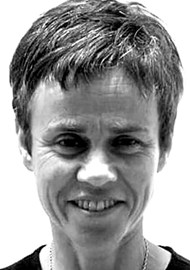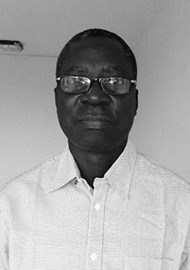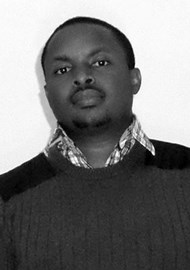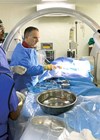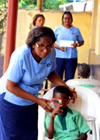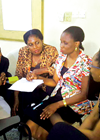VISION 2020 LINKS between Western Health and Social Care Trust (WHSCT), Altnagelvin Area Hospital, Northern Ireland with first ECWA Eye Hospital, Kano, Nigeria and now also with Mbeya Referral Hospital (MRH), Tanzania, have been beneficial to all three partners.
From the UK perspective, having a VISION 2020 LINK has been good for local morale, it has resulted in new friendships being forged, improved a sense of belonging to the workplace and helped staff retention. There has been widespread support for fundraising activities and 11 people have been involved in training visits to our LINK partner hospitals, firstly ECWA Eye Hospital, Kano, Nigeria since 2009, and more recently Mbeya Referral Hospital, Tanzania.
Many people have given time to facilitate plans: sourcing equipment, giving advice on statistics for writing papers, arranging accommodation, making posters for eye health promotion in our LINK partner hospitals and to increasing local awareness of the LINKS. Senior management has been pleased to have good publicity for the Trust within the local press (articles carried in nine different newspapers) and several interviews on the local radio station (BBC Foyle).
On a clinical level it has been useful to notice how much of what we do is dependent on patients being referred in a timely way and then having access to functioning equipment in the hospital and good quality drugs in the community. The freedom to make decisions based on clinical need rather than the patient’s ability to pay is something I had previously taken for granted working within the NHS. It has also been salutary realising the value of the team approach in the NHS, which encompasses so many aspects of patient care: primary care and referral pathways, measures to promote patient safety especially in theatre, National Institute for Health & Care Excellence (NICE) guidelines.
My case mix as an ophthalmologist is somewhat different to that of Dr Abuh (Ophthalmologist in Kano, Nigeria) and Dr Barnabas (Ophthalmologist in Mbeya, Tanzania). The most striking is the difference in the numbers of children with retinoblastoma and cataract that they see compared to the small numbers that present to me in Northern Ireland. After our first visit to Kano I knew that I personally could not help much with retinoblastoma management and so explored pre-existing African solutions. As a result Dr Abuh and I went to the third Kenyan national retinoblastoma strategy meeting.
This taught us a lot, most notably the importance of increasing awareness of leukocoria so that early referrals could result in lives saved, and the benefit of chemotherapy in neglected tumours allowing enucleation rather than exenteration. Dr Abuh has done over 700 paediatric cataracts. He has much more to offer Dr Barnabas in paediatric cataract surgical management than I have and so we are establishing a three-way LINK. I anticipate that this LINK will also be helpful to Dr Barnabas in addressing resource procurement and financial sustainability.
Having Dr Abuh and Dr Barnabas on clinical attachment together at WHSCT, Altnagelvin for two months in early 2015 has enabled both of them to learn from each other as well as from the clinical practice and procedures that they observe here.
The two case studies below highlight the impact of our LINK on our partner hospitals in Nigeria and Tanzania. We are disappointed that security issues in northern Nigeria mean that WHSCT staff can no longer go out to train their counterparts. But we are confident that our LINK will continue and that it will develop and grow as a three-way partnership between Nigeria, Tanzania and Northern Ireland.
Case study 1
Benefits of a VISION 2020 LINK – the Nigerian perspective
By Dr Sunday Abuh, Ophthalmologist and Medical Director, ECWA Eye Hospital, Kano, Nigeria.
Kano is located in the North Central part of Nigeria and has a population of about 10 million people.
The hospital was established by the Sudan Interior Mission (SIM) in 1943 and has remained a high-volume service centre to Kano and all the surrounding states and countries like Niger Republic, Chad and Cameroon. A lot of patients also come from the southern part of Nigeria.
We take part in the training of primary eye care nurses, theatre nurses, resident ophthalmologists and consultants who want to aquire surgical skills. We were recently upgraded to undertake full residency training in ophthalmology.
ECWA is a 175-bed eye hospital with four doctors at the moment, two of whom are consultant ophthalmologists and the remaining two are resident (training) ophthalmologists. Of the two consultants one is a paediatric ophthalmologist and the other has an interest in glaucoma. We have about 40 community eye health workers, seven nurses and two ophthalmic nurses. We have just concluded a programme funded by ‘Seeing is Believing’ of Standard Chartered Bank, which ran for the last three years focusing on adult and paediatric cataract. In that time a total of 18,200 adult cataract and 540 paediatric catatract surgeries were done.
The LINK between ECWA Eye Hospital, Kano and the Western Health and Social Care Trust, Altnagelvin Area Hospital, has boosted the standard of services we offer in all areas of ophthalmology by offering on-the-job training to different categories of our staff. It was a mentoring programme in which each person worked directly with his or her colleague for direct learning. The benefits were way beyond the stated aims and objectives.
The LINK raised the standard of services we provide as an eye hospital in the following ways:
1. Biometry: We had been doing intraocular lens implant microsurgery since 1994, but no-one had been taught how to do correct biometry. This practice was taught theoretically and practically through the LINK with the Altnagelvin team. We can therefore confidently say that this has positively impacted on the outcome of our cataract surgery for both adults and children.
2. Theatre management: Our nurses learned how to manage the theatre; today the theatre is better kept and well organised to cope with the daily heavy surgery list.
3. Anaesthesia: The teaching of the use of laryngeal mask over endotracheal intubation had a wonderful impact on our anaesthesia. Anaesthesia was made easy through this method and safety was much improved over our previous records. We have done 700 paediatric cataracts, which means 700 children have been anaesthetised and no single record of death.
4. Refraction / prescription of glasses: There has been significant improvement in this area as our optometrist, even though they had practised for several years before taking part in the LINK, is now better at refraction, especially cycloplegic refraction, and spectacles prescription for children.
5. Squint assessment / surgery: Working with orthoptists and the Paediatric Ophthalmologist Rosie Brennan has greatly improved my own knowledge and skills in handling basic strabismus.
6. Equipment and materials: Many of our items of equipment that were broken down were revitalised by the biomedical engineer from WHSCT who participated in the LINK. The biomedical technician at ECWA Hospital improved his knowledge of equipment maintenance. The LINK donated a number of pieces of equipment to us, ranging from spare parts for maintaining equipment to ‘Little Sister’ autoclaves, an operating microscope and various eye consumables including intraocular lenses. All these in no small way added to the quality of our services and were also a source of income to the hospital.
7. Usage of visual field analyser: Ophthalmic staff were thoroughly taught on the usage of this equipment which was merely trial and error before the LINK. Today, other nurses have also learned from their colleagues.
8. Retinoblastoma: Management of this disease was improved through the LINK. Today we are up to date in the management of neglected retinoblastoma. We have managed about 100 cases so far.
9. Post-LINK communications: Even though the LINK is no longer two-way, as WHSCT staff are unable to travel to our part of northern Nigeria because of security concerns, there is still a relationship between the LINK partners. We continue to review patients together on the phone. We also enjoy support in different areas. Earlier in 2015 I was able to have a two-month clinical attachment in paediatric ophthalmology and strabismus at Altnagelvin with Rosie Brennan and her team. This was thanks to a Fellowship awarded by the Commonwealth Eye Health Consortium, funded by The Queen Elizabeth Diamond Jubilee Trust, for which I am extremely grateful.

Barnabas Mshangila, Rosie Brennan and Sunday Abuh
discussing adjustable suture surgery.

Barnabas Mshangila and Sunday Abuh observing Rosie Brennan
in theatre (with patient consent to photo).
Case study 2
A three-way VISION 2020 LINK: early learning and hopes for the future
By Dr Barnabas Mshangila, Consultant Ophthalmologist, Mbeya Referral Hospital (MRH), Mbeya, Tanzania.
In the two months of my clinical attachment in Northern Ireland, I have learnt a lot of clinical, non-clinical and surgical management of patients. I am very grateful to The Queen Elizabeth Diamond Jubilee Trust for funding my fellowship attachment with Mrs Brennan and her team. Below are the things that I have learnt, what I’m planning to do when I go back to Mbeya and my hopes for the LINK with WHSCT Altnagelvin in future.
Things that I have learnt and I can confidently do:
- Assessment of strabismus, both motor (cover test, ocular motility and measurement of deviations) and sensory (Fusion, stereopsis, Prism fusion range, 4D prism base out taste, convergency and accommodation)
- Appropriate strabismus management for both adults and children such as spectacles, surgery, prisms
- Assessment of paediatric visual acuity for different age groups
- Assessment of ptosis and its appropriate management
- Assessment of other paediatric eye conditions such as congenital glaucoma, amblyopia and cataract
I have also learnt different surgical procedures such as:
- Horizontal strabismus surgery using adjustable and non-adjustable sutures
- Ptosis correction – Muller muscle resection
- Lower eyelid entropion / ectropion correction
- Adult cataract surgery
- Adult trabeculectomy
- Lower eyelid reconstruction surgery
Non-clinical skills I have learnt:
- Communication skills: I have learnt better ways of communicating with patients. All service providers introduce themselves to patients, explain clinical findings and diagnosis and give time to patients to ask questions or for clarifications
- Patient-focused attitude: every person involved in patient care dedicates fully his or her time and efforts to serving patients
- Economic management strategies: I have learnt some self-sustaining strategies from Dr Abuh, Ophthalmologist and Medical Director of an eye hospital in Kano, Nigeria. He has had a LINK with WHSCT for several years and has been undertaking a clinical attachment at WHSCT with Rosie Brennan and her team at the same time as me. Sharing learning with Dr Abuh has added greatly to my experience in Northern Ireland. It is exciting to be part of a three-way LINK: MRH/Altnagelvin/Kano
My expectations when I go back to MRH:
- To share with other staff members in the department what I have learnt (clinical and non-clinical), to improve the quality of service in our department
- To establish a dedicated paediatric eye clinic and put into practice what I have learnt and continue learning through the LINK
- To start to perform paediatric ocular surgeries, e.g. squint surgery, ptosis and developmental cataract surgery (once I have the appropriate surgical equipment)
- To discuss with my hospital management the economic self-sustaining strategies
My hopes for the LINK:
I hope the LINK will empower us to deliver high quality eye services in MRH. This will be achieved through:
- Exchange of knowledge and skills between team members of different disciplines during the training visits
- Advice on the acquisition of important equipment such as biometry machine, YAG laser and surgical instruments
- Expansion of the LINK to involve other specialties, e.g. medical retina and glaucoma
Website: http://iceh.lshtm.ac.uk

COMMENTS ARE WELCOME


